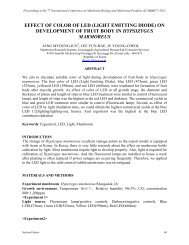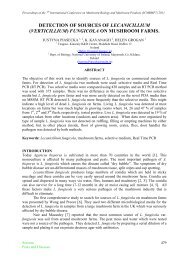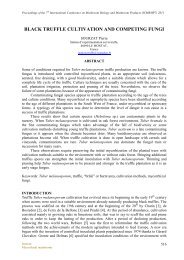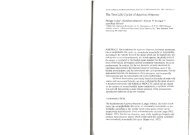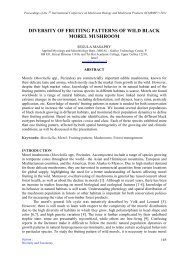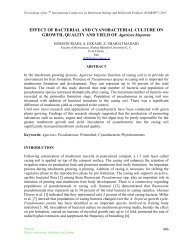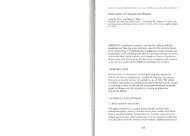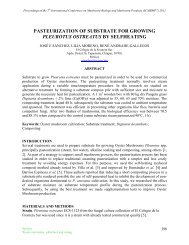Strain improvement of edible fungi with Pleurotus eryngii ...
Strain improvement of edible fungi with Pleurotus eryngii ...
Strain improvement of edible fungi with Pleurotus eryngii ...
Create successful ePaper yourself
Turn your PDF publications into a flip-book with our unique Google optimized e-Paper software.
Proceedings <strong>of</strong> the 7 th International Conference on Mushroom Biology and Mushroom Products (ICMBMP7) 2011<br />
MATERIALS AND METHODS<br />
<strong>Strain</strong>s. Following strains were used for production <strong>of</strong> hybrids by mating neohaplonts and<br />
dikaryotic strains: A commercial P. <strong>eryngii</strong> dikaryon [1], 11 neohaplonts (designated from PeC9<br />
to PeC45) recovered by dedikaryotization from the commercial P. <strong>eryngii</strong> dikaryon [2], 4 L.<br />
edodes dikaryons (L9, L10, L18, L21) [3], a dikaryotic <strong>Pleurotus</strong> djamor strain [4], 8 <strong>Pleurotus</strong><br />
spp. dikaryons (Asp14, CP50, CP253, HK3539, IE200, IE201, P401 and <strong>Pleurotus</strong> sp. PB) and 6<br />
neohaplonts (designated from L10-1S to L21-2S) recovered by dedikaryorization <strong>of</strong> L. edodes<br />
strains [2]. All strains are stored in the fungal collection <strong>of</strong> the Department <strong>of</strong> Food Science and<br />
Biotechnology at the Faculty <strong>of</strong> Chemistry (University <strong>of</strong> México). The strains were propagated<br />
in malt extract agar (MEA) (1.5% malt extract and 2% agar); cultures on MEA plates (Petri<br />
dishes) were stored at 2 to 4°C [3].<br />
Hybrids from Matings <strong>of</strong> P. <strong>eryngii</strong> Neohaplonts <strong>with</strong> L. edodes Neohaplonts. Agar cubes (2<br />
mm) full <strong>with</strong> growing mycelia were cut from the edge <strong>of</strong> growing cultures <strong>of</strong> selected P. <strong>eryngii</strong><br />
and L. edodes neohaplonts. They were placed side by side on MEA plates and incubated at 24ºC.<br />
Developing colonies were inspected under the microscope during the following 7 days and those<br />
showing clamp connections were reseeded on MEA plates for further evaluation.<br />
Hybrids from Di-mon Matings <strong>of</strong> P. <strong>eryngii</strong> Neohaplonts <strong>with</strong> <strong>Pleurotus</strong> spp. Dikaryons.<br />
Four agar cubes (2 mm) full <strong>with</strong> growing mycelia were cut from the edge <strong>of</strong> a growing culture<br />
<strong>of</strong> a selected P. <strong>eryngii</strong> neohaplont and symmetrically distributed on the surface <strong>of</strong> a MEA plate<br />
and incubated at 24ºC until development <strong>of</strong> 1 cm (∅) colonies. At this stage, a 2 mm agar cube<br />
was cut from the edge <strong>of</strong> a growing culture <strong>of</strong> a selected dikaryon and placed on the periphery <strong>of</strong><br />
the growing neohaplont culture. Plates were again incubated at 24ºC and inspected under the<br />
microscope every day until appearance <strong>of</strong> clamp connections on the side opposite to the point <strong>of</strong><br />
inoculation <strong>of</strong> the dikaryotic culture. The newly emerging dikaryotic strain (hybrid) was<br />
recovered on MEA plates. Mycelium growth <strong>of</strong> all resulting hybrids as well as <strong>of</strong> their respective<br />
parental dikaryons and neohaplonts was evaluated by placing 8 mm (∅) inocula cut from the<br />
edge <strong>of</strong> a growing culture and placed on MEA, <strong>with</strong> 3 replicates per strain. Colony diameters<br />
were measured after 3, 6 and 9 days incubation and when significant differences were<br />
established by variance analysis, strains were classified according to Duncan test.<br />
Fruiting <strong>of</strong> Hybrid <strong>Strain</strong>s. Two types <strong>of</strong> substrates were used for fruiting <strong>of</strong> hybrids, one is<br />
recommended for fruiting <strong>of</strong> P. <strong>eryngii</strong> and the second one for L. edodes (Table 1).<br />
Table 1: Substrates for fruiting <strong>of</strong> P. <strong>eryngii</strong> and L. edodes hybrids and parental strains<br />
Components<br />
Substrates (% fresh weight)<br />
L. edodes P. <strong>eryngii</strong><br />
Sawdust 50.0 20.0<br />
Cottonseed waste 36.0 60.0<br />
Millet 6.0 -----<br />
Sorghum (milled) 6.0 -----<br />
Wheat bran ----- 16.0<br />
Ammonium sulfate 0.5 -----<br />
Citric acid 0.5 -----<br />
Benlate 1.0 -----<br />
Calcium carbonate ----- 3.0<br />
Calcium sulfate ----- 1.0<br />
Section:<br />
Genomics, Genetics and Breeding<br />
63



